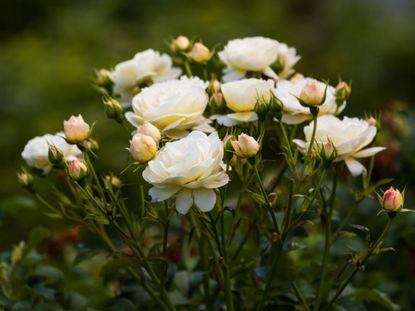What Is Disbudding A Rose Bush?


If you have ever been around some very serious rose lovers, also sometimes known as Rosarians, it does not take long to hear the term disbudding. Disbudding is the practice of removing some of the buds on a rose bush at a very early stage of the bud's development. Usually, the little buds are removed by pinching them off with the thumbnail up tight to the area where they are forming.
Why You Would Want to Disbud a Rose Bush?
By doing the disbudding, a cluster of blooms on a floribunda or grandiflora rose bush will typically produce bigger blooms in the cluster, thus a very showy looking bouquet or spray of blooms. If the main center bud is removed from the cluster of buds on a floribunda rose bush, the other buds will typically open at the same time, thus creating a big full beautiful bouquet or spray of blooms. Those who show their roses at rose shows tend to practice the disbudding of their rose bushes more than others, as by doing so you also lose those buds blooming. Another reason for disbudding is extremely difficult to do. When we buy a beautiful blooming rose bush from our local nursery, greenhouse, or garden center, we buy it for the blooms. However, when we transplant that rose bush into our gardens or new containers, it does shock the bush. Using root stimulators will help with the transplant shock but will not totally remove it. Thus, while the rose bush is trying to establish its root system into its new environment, it is also trying to supply the needs of making those buds grow and open into blooms. The rose bush trying to do both puts a huge load of stress upon it. The best thing to do with our newly planted rose bushes is to totally remove all the buds and blooms that are currently on them. Allow the rose bush to get its root system re-established and then put out some new buds and blooms. As I said, this is extremely difficult to do, even though it really helps the rose bush out and will add to its strength and vigor later. I recommend that folks remove at least half of the buds and blooms from their newly planted roses, as this does help the rose bush use less energy on the bloom production and more on the root system establishment. It really is a matter of what is going to give you a healthier, happier, and more vigorous rose bush in the long run instead of immediate satisfaction.
Disbudding Hybrid Tea Roses
Most hybrid tea roses produce blooms one to a stem, but some tend to put on extra buds. In such cases, it is a matter of choice as to disbud or not. If you like to show your roses at rose shows, it is important to perform the disbudding as soon as possible so that the bud left will grow nice and big, thus producing a big, beautiful prize-winning bloom. If you just love how your roses look in your rose bed or rose garden plus the wonderful fragrance, then leaving the extra buds may be the choice. Even if I am not planning on showing my roses, I will disbud my rose bushes some if they get overloaded with buds. The rose bush trying to push out an overload of blooms tends to make them smaller, and they do not last as long. The shrub roses and climbing roses are the exception though, as they love to push out lots of buds and blooms. They tend to handle the chore with ease most of the time unless stressed in some way.
Disbudding Miniature and Mini Flora Rose
Miniature and mini flora rose bushes may be disbudded too so that their single blooms or bloom clusters are a bit bigger. It is a bit more difficult chore to disbud these little ladies, as their buds are pretty small to begin with and you can easily take more buds off than you really wanted to. So be careful with disbudding them and go slow. With these rose bushes, the disbudding is done by many of those who show their roses as well. Those who love how the roses load up with beautiful blooms in their gardens or containers have no real interest in doing any disbudding.
Gardening tips, videos, info and more delivered right to your inbox!
Sign up for the Gardening Know How newsletter today and receive a free download of our most popular eBook "How to Grow Delicious Tomatoes."

Stan V. Griep contributed to Gardening Know How for many years. An American Rose Society Consulting Master Rosarian in the Rocky Mountain District, he served as Gardening Know How's in-house expert on all things roses.
-
 Want a Backyard Mini Orchard? Create Your Own Container Orchard
Want a Backyard Mini Orchard? Create Your Own Container OrchardEasier to care for in small spaces, a backyard mini-orchard makes sense for busy gardeners and juicy fruit is the reward.
By Teo Spengler
-
 Urban Beekeeping Guide: Top Tips For Raising Bees In The City
Urban Beekeeping Guide: Top Tips For Raising Bees In The CityUrban beekeeping can be a rewarding and appreciated pastime, but first be sure it’s legal in your city and learn the ropes of beekeeping.
By Mary Ellen Ellis